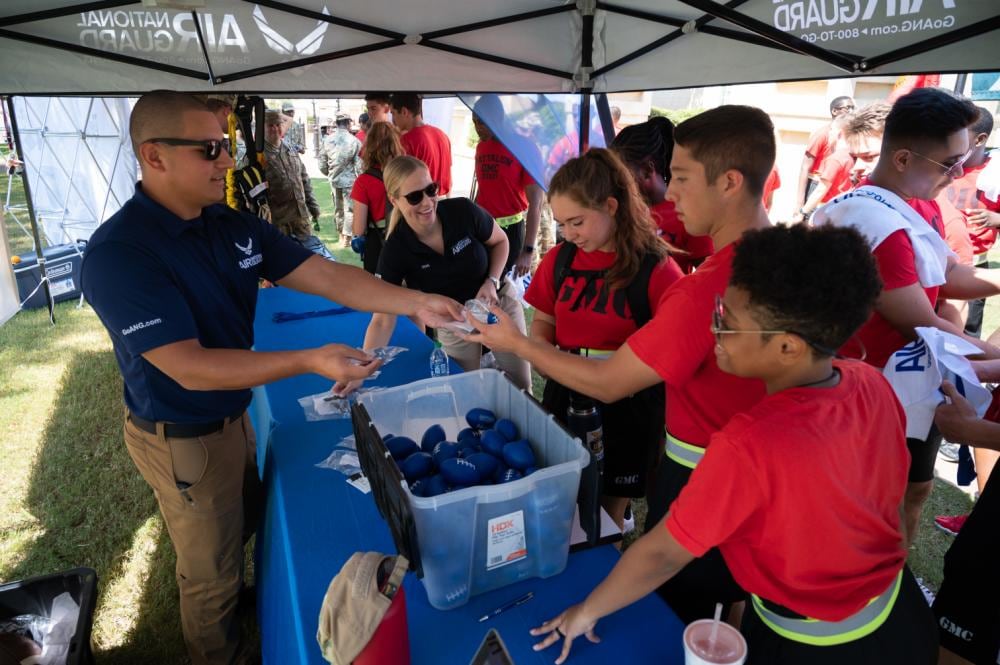The Air Force has loosened its restrictions on body fat for new recruits, one of the latest moves to grow the pool of potential applicants amid the military’s recruiting crisis.
In the past, men and women’s bodies needed to be 20% or 28% fat, respectively, to be eligible for service. That benchmark is now 26% for men and 36% for women, Air Force Recruiting Service spokesperson Leslie Brown said Monday.
The American Council on Exercise categorizes as obese those with body fat percentages over 25% for men and 32% for women. The old Air Force benchmark fell into the range of “acceptable” fat, according to the organization.
RELATED

Officials changed the body fat standard based on the recommendation of a team, led by Air Force Vice Chief of Staff Gen. David Allvin, that was formed to look at recruiting challenges. They anticipate that 50 to 100 more people could join the Air Force each month as a result, Brown said.
The change reflects an attempt to adapt to the national obesity crisis that has stymied military recruiting compared to earlier, svelter decades.
A Johns Hopkins University study published in 2021 and updated in February found that more than half of Americans age 18-25 are overweight or obese, based on their body mass index. BMI is one measure of body composition that is calculated by dividing a person’s weight by their height.
The percentage of Americans in that age range with a BMI indicating a normal weight dropped from about 70% to 34% between 1976 and 2018, the study found.
RELATED

Last month, Air Force personnel boss Lt. Gen. Caroline Miller told congressional lawmakers the service expected to miss its fiscal 2023 active duty recruiting goal by around 4,100 people. The Air National Guard and Air Force Reserve project they will fall short by about 4,600 and 3,600 recruits, respectively.
Halfway through the fiscal year, the active duty Air Force has brought in less than 50% of its goal of 26,877 new airmen for 2023. Around 11,200 recruits have come in so far, Miller said.
Weight isn’t the only factor holding the Air Force back. A strong civilian job market and a lack of interest in the military have become major roadblocks among young Americans, recruiting officials say. And the Pentagon still has dozens of other health restrictions, from eczema to diabetes to antidepressant use, that could disqualify applicants.
Whatever their body composition when they join, new airmen will be subjected to the same annual fitness tests and standards as everyone else.
RELATED

This month, the Air Force is beginning its new body composition test that relies on a person’s height-to-waist ratio, rather than measuring abdominal circumference to judge their health. The service cautions that excess belly fat can increase a person’s risk of cardiovascular disease, stroke, diabetes, hypertension and musculoskeletal injuries.
To calculate the ratio, service members are instructed to wrap a measuring tape around the narrowest point of the abdomen — the “midpoint between the lowest rib and the top of the hip bone,” the Air Force said. Divide that number by height in inches.
People meet the new standard if that totals less than 0.55, or are considered “high risk” if they exceed 0.55.
While people won’t be punished for at least a year if they don’t pass, commanders can still reprimand troops for missing subsequent tests or appointments. And if an airman isn’t in better shape after 12 months, the service will send them to a formal fitness program and consider taking administrative action, including separation.
Rachel Cohen is the editor of Air Force Times. She joined the publication as its senior reporter in March 2021. Her work has appeared in the Washington Post, the Frederick News-Post (Md.), Air and Space Forces Magazine, Inside Defense, Inside Health Policy and elsewhere.





